The Separation Effect of Heat Treatment on Chili Seeds Based on Seed Viability
Abstract
1. Introduction
2. Materials and Methods
2.1. Test Materials
2.2. Measurement Methods for Physical Parameters
2.2.1. Measurement of Poisson’s Ratio and Elastic Modulus
2.2.2. Measurement of Thermal Expansion Coefficient
2.2.3. Measurement of Water Absorption Rate
2.3. Measurement Methods of Thermal Properties Parameters
2.3.1. Measurement of Specific Heat Capacity
2.3.2. Measurement of Thermal Conductivity
3. Results
3.1. Results for Physical Parameters
3.1.1. Poisson’s Ratio and Elastic Modulus
3.1.2. Thermal Expansion Coefficient
3.1.3. Water Absorption Rate
3.2. Results for Thermal Properties Parameters
3.2.1. Specific Heat Capacity
3.2.2. Thermal Conductivity
3.3. Thermal Property Parameter Model Analysis
3.4. Activity Verification of Chili Seeds Under Different Temperature Conditions
3.5. The Thermal Steady-State Simulation Test
4. Discussion
5. Conclusions
Author Contributions
Funding
Institutional Review Board Statement
Informed Consent Statement
Data Availability Statement
Conflicts of Interest
References
- Duan, Y.; Han, W.; Guo, P.; Wei, X. YOLOv8-GDCI: Research on the Phytophthora Blight Detection Method of Different Parts of Chili Based on Improved YOLOv8 Model. Agronomy 2024, 14, 2734. [Google Scholar] [CrossRef]
- Zhang, D.; Sun, X.; Battino, M.; Wei, X.; Shi, J.; Zhao, L.; Zou, X. A comparative overview on chili pepper (capsicum genus) and sichuan pepper (zanthoxylum genus): From pungent spices to pharma-foods. Trends Food Sci. Technol. 2021, 117, 148–162. [Google Scholar] [CrossRef]
- Kim, D.; Park, H.; Cho, I.H. The effect of roasting on capsaicinoids, volatile compounds, and fatty acids in Capsicum annuum L.(red pepper) seeds. Food Sci. Biotechnol. 2022, 31, 211–220. [Google Scholar] [CrossRef]
- Cvetković, T.; Ranilović, J.; Jokić, S. Quality of Pepper Seed By-Products: A Review. Foods 2022, 11, 748. [Google Scholar] [CrossRef]
- Shayfull, Z.; Fathullah, M.; Shuaib, N.A.; Nasir, S.M. Design and Development of Dried Chilies Seed Separating Machine. Int. J. Basic Appl. Sci. 2011, 11, 7–10. [Google Scholar]
- Ghazali, A.; Sharun, S.M.; Abdullah, S.H.Y.S.; Yap, F.A.; Ariffin, N.H. Automatic chili seeds remover for household and small-medium enterprises as an alternative of hand cutting method. AIP Conf. Proc. 2021, 2347, 020174. [Google Scholar]
- Hassan, M.F.; Sebari, M.M.; Ali, M.H. Design and Development of Dried Chili Seeds Separator Machine. J. Des. Sustain. Environ. 2020, 2, 1–7. [Google Scholar]
- Hermanto, M.B.; Susilo, B.; Lutfi, M.; Damayanti, R.; Yanti, Y.; Irshafiyah, I. The influence of seed separation techniques and drying temperature in a dehumidified drying machine for tomato seed production. Adv. Food Sci. Sustain. Agric. Agroind. Eng. (AFSSAAE) 2024, 7, 67–77. [Google Scholar] [CrossRef]
- Wang, M.; Tang, Z.; Zhang, B.; Li, Y. Differences in breaking behavior of rice leaves under microwave and naturally drying processes. Int. J. Agric. Biol. Eng. 2022, 15, 89–100. [Google Scholar] [CrossRef]
- Yu, H.; Yu, H.; Zhang, B.; Chen, M.; Liu, Y.; Sui, Y. Quantitative perturbation analysis of plant factory LED heat dissipation on crop microclimate. Horticulturae 2023, 9, 660. [Google Scholar] [CrossRef]
- Liu, Z.; Chen, J.; Guo, J.; Qiu, B. Numerical Simulation and Validation of Droplet Deposition on Tomato Leaf Surface Under Air-Assisted Spraying. Agronomy 2024, 14, 1661. [Google Scholar] [CrossRef]
- Ou, M.; Zhang, Y.; Wu, M.; Wang, C.; Dai, S.; Wang, M.; Jiang, L. Development and Experiment of an Air-Assisted Sprayer for Vineyard Pesticide Application. Agriculture 2024, 14, 2279. [Google Scholar] [CrossRef]
- Tang, P.; Li, H.; Issaka, Z.; Chen, C. Impact forces on the drive spoon of a large cannon irrigation sprinkler: Simple theory, CFD numerical simulation and validation. Biosyst. Eng. 2017, 159, 1–9. [Google Scholar] [CrossRef]
- Xu, L.; Li, Y.; Chai, X.; Wang, G.; Liang, Z.; Li, Y.; Li, B. Numerical simulation of gas–solid two-phase flow to predict the cleaning performance of rice combine harvesters. Biosyst. Eng. 2020, 190, 11–24. [Google Scholar] [CrossRef]
- Khan, S.A.; Taj, F.; Habib, S.; Shawl, F.; Dar, A.H.; Dwivedi, M. CFD Analysis of Drying of Cereal, Fruits, and Vegetables. In Advanced Computational Techniques for Heat and Mass Transfer in Food Processing; CRC Press: Boca Raton, FL, USA, 2022; pp. 235–246. [Google Scholar]
- ElGamal, R.A.; Kishk, S.S.; ElMasry, G.M. Validation of CFD models for the deep-bed drying of rice using thermal imaging. Biosyst. Eng. 2017, 161, 135–144. [Google Scholar] [CrossRef]
- Elgamal, R.; Ronsse, F.; Radwan, S.M.; Pieters, J.G. Coupling CFD and diffusion models for analyzing the convective drying behavior of a single rice kernel. Dry. Technol. 2014, 32, 311–320. [Google Scholar] [CrossRef]
- Chen, P.; Fan, M.; Zhu, W.; Liu, Y.; Jiang, M.; Wang, Y.; Wang, X. Numerical simulation of hot air drying of wheat grain piles based on CFD-DEM and experimental research. Dry. Technol. 2024, 42, 199–211. [Google Scholar] [CrossRef]
- Coradi, P.C.; Lemes, Â.F.C. Experimental prototype of silo-dryer-aerator of grains using Computational Fluid Dynamics (CFD) system. Acta Sci. Technol. 2019, 41, e36949. [Google Scholar] [CrossRef]
- Liu, W.; Chen, G.; Zheng, D.; Ge, M.; Liu, C. Effects of the broken kernel on heat and moisture transfer in fixed-bed corn drying using particle-resolved CFD model. Agriculture 2023, 13, 1470. [Google Scholar] [CrossRef]
- Sanghi, A.; Ambrose, R.K.; Maier, D. CFD simulation of corn drying in a natural convection solar dryer. Dry. Technol. 2018, 36, 859–870. [Google Scholar] [CrossRef]
- McIntyre, J.S.; Butts, C.L.; Read, Q.D. Computational fluid dynamics modeled air speed through in-shell peanuts in drying wagons compared to measured air speed. Appl. Eng. Agric. 2022, 38, 489–508. [Google Scholar] [CrossRef]
- Xu, H.; Zhang, P.; Hu, Z.; Mao, E.; Yan, J.; Yang, H. Analysis of dust diffusion from a self-propelled peanut combine using computational fluid dynamics. Biosyst. Eng. 2022, 215, 104–114. [Google Scholar] [CrossRef]
- Hou, Z.; Duan, X.; Zhao, Y.; Ren, G.; Li, L.; Cao, W.; Liu, W. Three-dimensional simulation of green soybean infrared-assisted spouted bed drying. J. Sci. Food Agric. 2024, 104, 3206–3215. [Google Scholar] [CrossRef]
- Park, H.W.; Yoon, W.B. Prediction of the intermittent drying behavior of soybeans [Glycine max (L.)] using novel multilayered mass transfer simulation with an image analysis. Dry. Technol. 2019, 37, 1228–1238. [Google Scholar] [CrossRef]
- Lu, F.Y.; Ma, X.; Tan, S.Y.; Chen, L.T.; Zeng, L.C.; An, P. Simulative calibration and experiment on main contact parameters of discrete elements for rice bud seeds. Trans. Chin. Soc. Agric. Eng. 2018, 49, 93–99. [Google Scholar]
- Du, C.; Han, D.; Song, Z.; Chen, Y.; Chen, X.; Wang, X. Calibration of contact parameters for complex shaped fruits based on discrete element method: The case of pod pepper (Capsicum annuum). Biosyst. Eng. 2023, 226, 43–54. [Google Scholar] [CrossRef]
- Zhang, J.; Kaiser, E.; Zhang, H.; Marcelis, L.F.; Vialet-Chabrand, S. A simple new method to determine leaf specific heat capacity. Plant Methods 2025, 21, 6. [Google Scholar] [CrossRef] [PubMed]
- Liu, W.; Chen, G.; Zheng, D.; Ge, M.; Liu, C. Numerical and experimental investigation of flow and heat transfer in a fixed bed of non-spherical grains using the DEM-CFD method. J. Food Process Eng. 2023, 46, e14362. [Google Scholar] [CrossRef]
- Chen, P.; Wang, X.; Fan, M.; Tian, G.; Zhu, W.; Zhu, Y.; Jin, Y. Simulation study of moisture and heat migration during hot air drying of corn with stacked structures based on CFD-DEM. J. Stored Prod. Res. 2025, 112, 102627. [Google Scholar] [CrossRef]
- Namazu, T.; Fujii, T.; Takahashi, M.; Tanaka, M.; Inoue, S. A Simple Experimental Technique for Measuring the Poisson’s Ratio of Microstructures. J. Microelectromech. Syst. 2013, 22, 625–636. [Google Scholar] [CrossRef]
- Hubbard, A.M.; Ren, Y.; Sarvestani, A.; Picu, C.R.; Varshney, V.; Nepal, D. Thermomechanical analysis (TMA) of vitrimers. Polym. Test. 2023, 118, 107877. [Google Scholar] [CrossRef]
- Shamsaei, M.; Carter, A.; Vaillancourt, M. A review on the heat transfer in asphalt pavements and urban heat island mitigation methods. Constr. Build. Mater. 2022, 359, 129350. [Google Scholar] [CrossRef]
- Liu, X.; Gui, N.; Yang, X.; Tu, J.; Jiang, S. A DEM-embedded finite element method for simulation of the transient heat conduction process in the pebble bed. Powder Technol. 2021, 377, 607–620. [Google Scholar] [CrossRef]
- Alrebdi, T.A.; Wudil, Y.S.; Ahmad, U.F.; Yakasai, F.A.; Mohammed, J.; Kallas, F.H. Predicting the thermal conductivity of Bi2Te3-based thermoelectric energy materials: A machine learning approach. Int. J. Therm. Sci. 2022, 181, 107784. [Google Scholar] [CrossRef]
- Bai, J.; Chen, X.; Fang, W.; Fang, H.; Wang, X. Design and Parameter Optimization of Fresh Chili Seed Extractor. Agriculture 2025, 15, 1336. [Google Scholar] [CrossRef]
- Zhang, M.; Qiu, Z.; Zheng, Z.; Qiao, X. Effects of Different Heat Treatment Conditions and Breaking Methods on the Quality of Garlic Puree. Food Res. Dev. 2019, 40, 62–67+90. [Google Scholar]
- Zhang, Q.; Zhao, M.; Zhang, Y.; Meng, X.; Wang, Y.; Xu, Y.; Li, S. Effect of Different Treatment Sequences on Juice Yield and Quality of Blackcurrant Juice. Food Res. Dev. 2024, 45, 1–6. [Google Scholar]
- Luna, B.; Chamorro, D.; Pérez, B. Effect of heat on seed germination and viability in species of Cistaceae. Plant Ecol. Divers. 2019, 12, 151–158. [Google Scholar] [CrossRef]
- Jiang, L.N.; Shang, J.J.; He, L.B.; Dan, J.M. Comparisons of microwave-assisted and conventional heating extraction of pectin from seed watermelon peel. Adv. Mater. Res. 2012, 550, 1801–1806. [Google Scholar] [CrossRef]
- Luo, D.; Zhu, Y.; Wang, M.; Hu, X.; Wu, J. Effects of pretreatment on characteristics and qualities of Chinesejujube drying by segmented intermittent microwave coupled with hot air. Trans. Chin. Soc. Agric. Eng. 2017, 33, 261–267. [Google Scholar]

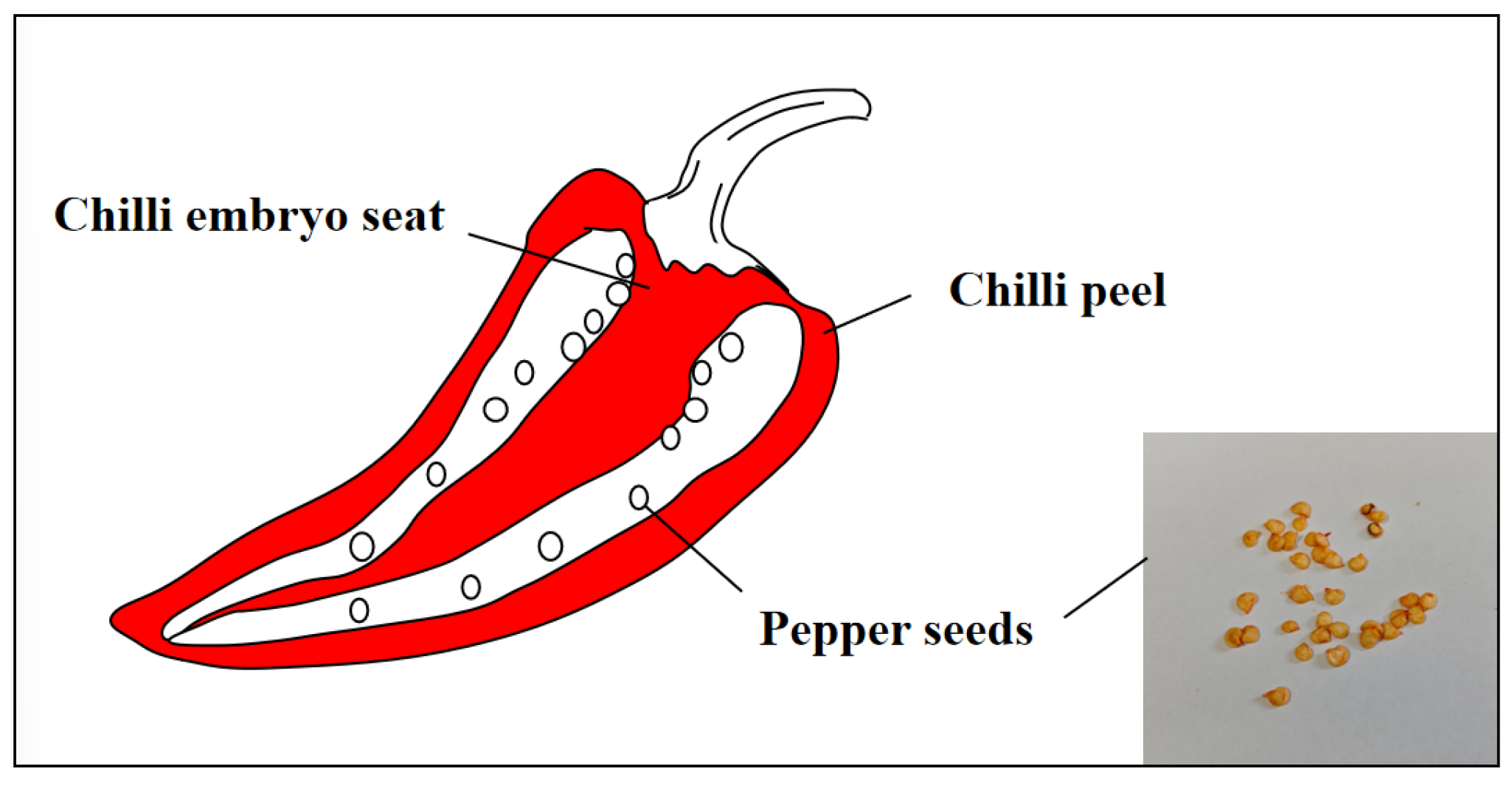
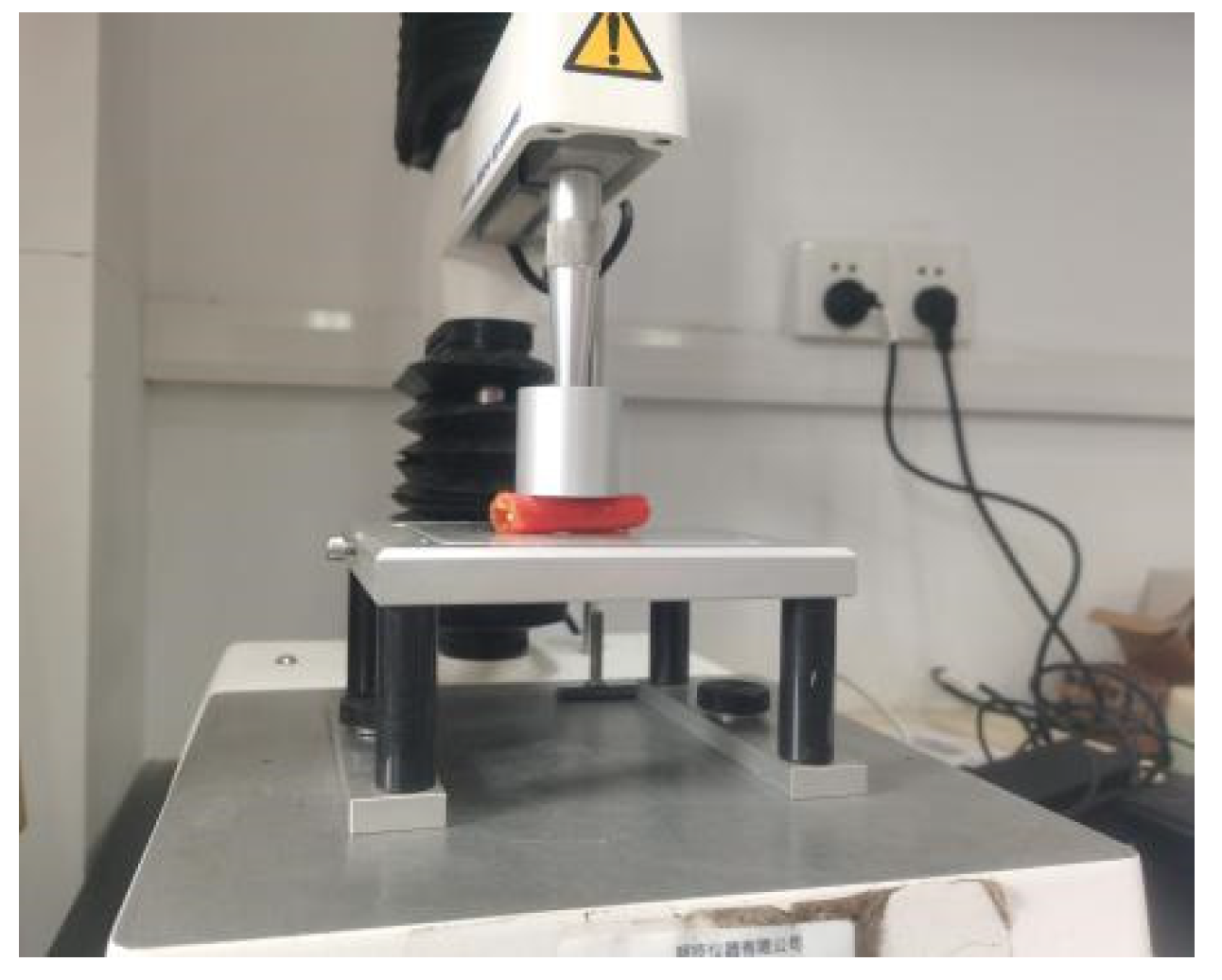
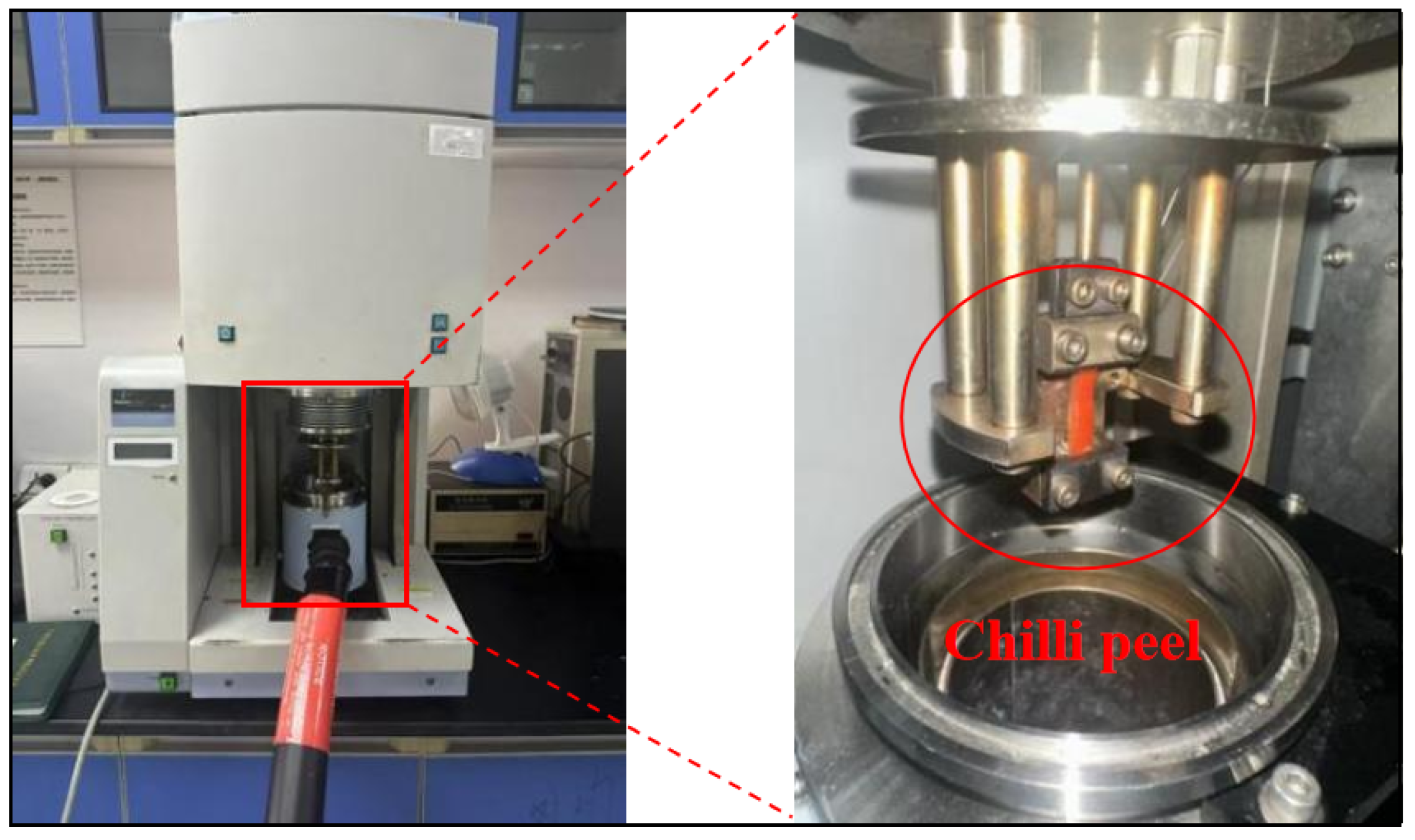


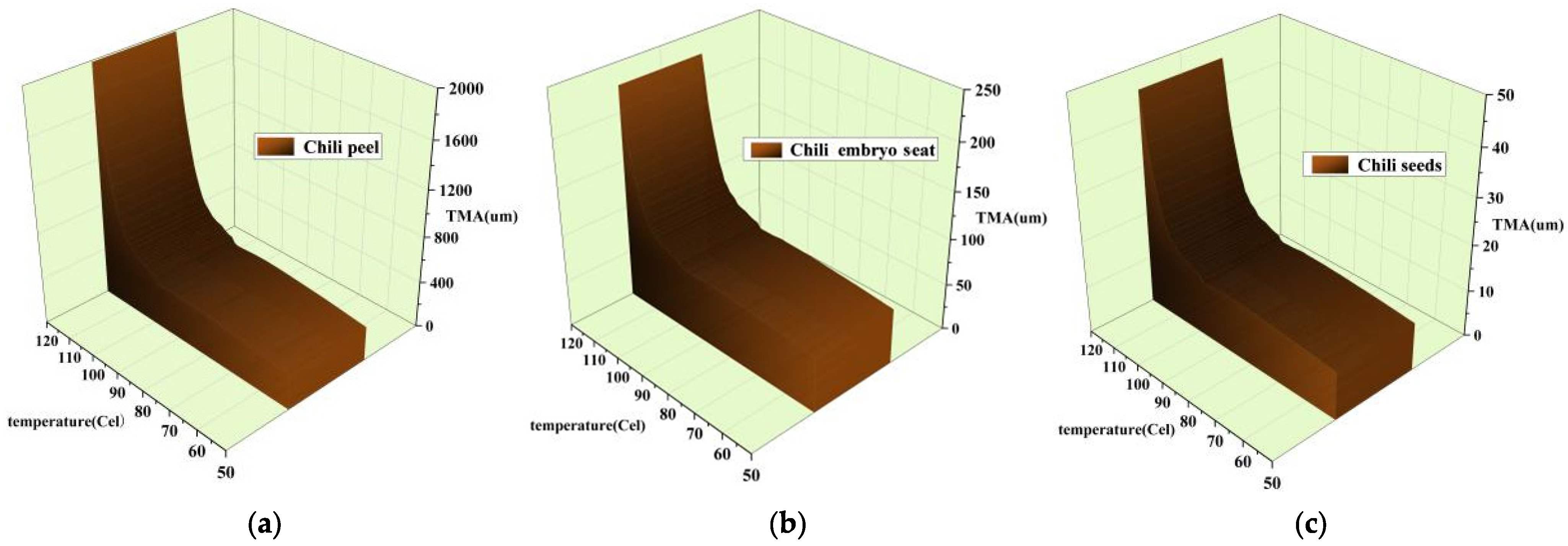



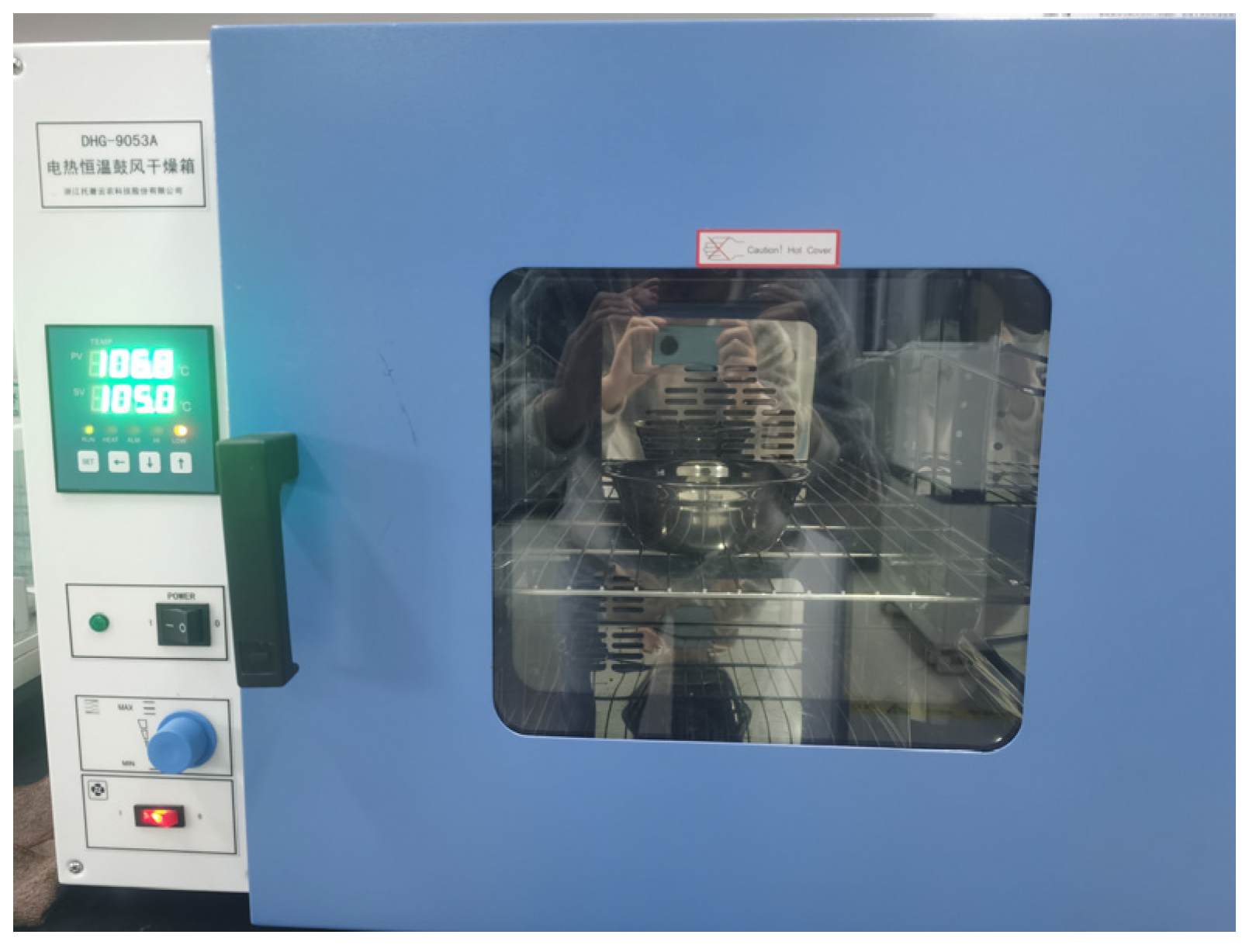
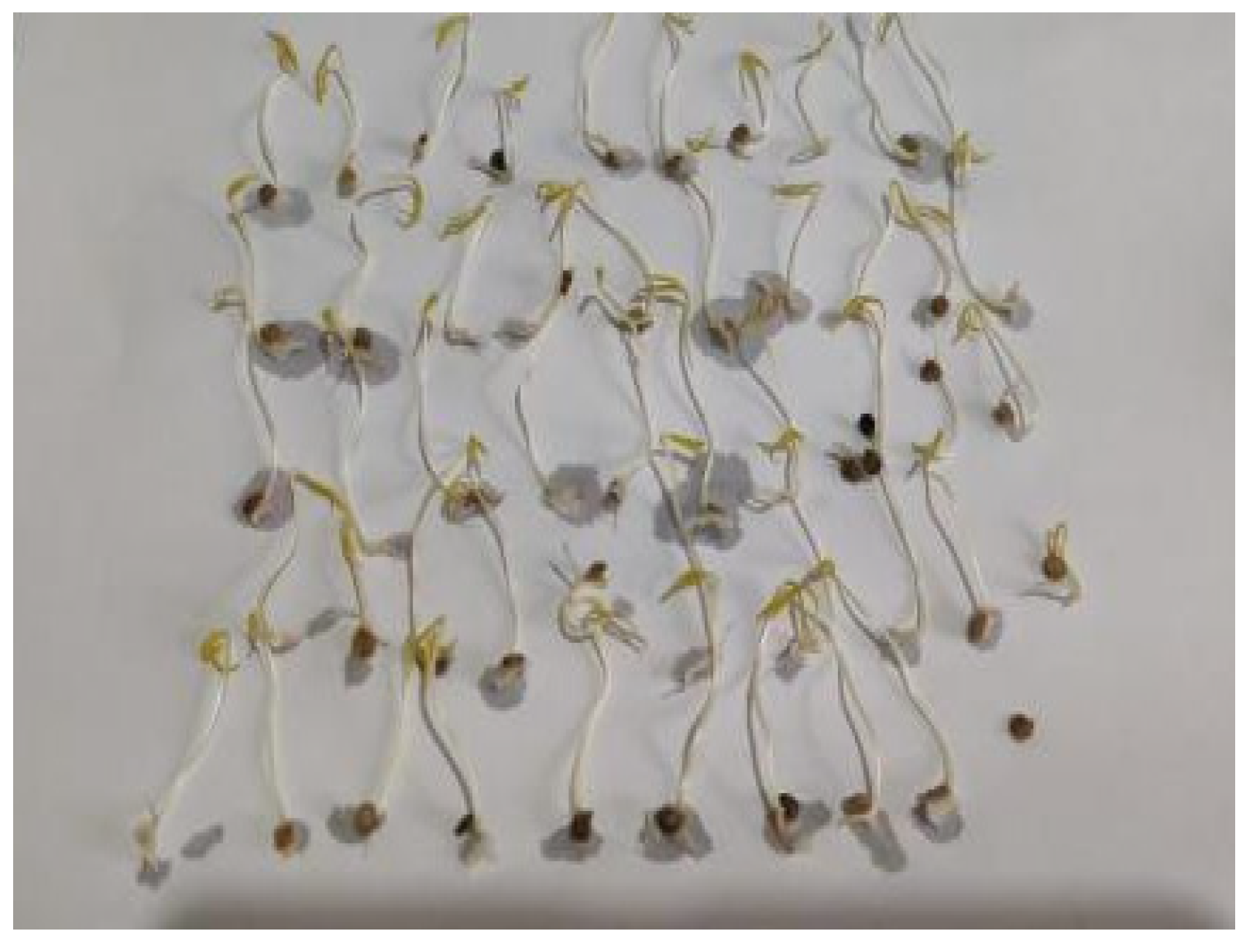


| Length Range/mm | Width/mm | Thickness/mm | |
|---|---|---|---|
| Line chili seeds | 3.83~4.41 | 2.86~3.51 | 0.81~1.05 |
| Line Chili Peel | Thread Chili Seeds | Line Chili Embryo Seat | |
|---|---|---|---|
| Sample group (kg/m3) | 943 ± 8.7 | 1065 ± 10.21 | 987 ± 9.61 |
| (Mpa) | (Mpa) | ||
|---|---|---|---|
| Thread Chili Seeds | 0.36 ± 0.13 | 23.41 ± 9.23 | 8.61 |
| Line Chili Peel | 0.42 ± 0.25 | 2.48 ± 1.67 | 0.87 |
| Line Chili Embryo Seat | 0.40 ± 0.18 | 3.56 ± 1.89 | 1.27 |
| Thread Chili Seeds | Line Chili Peel | Line Chili Embryo Seat | |
|---|---|---|---|
| Thermal expansion coefficient (1/°C) | 0.0000297–0.000124 | 0.000875–0.007570 | 0.0000216–0.000156 |
| Thread Chili Seeds | Line Chili Peel | Line Chili Embryo Seat | |
|---|---|---|---|
| Specific heat capacity (J/g·°C) | 1.684–1.821 | 1.824–2.016 | 1.781–1.922 |
| Thread Chili Seeds | Line Chili Peel | Line Chili Embryo Seat | |
|---|---|---|---|
| Thermal conductivity (W/m·K) | 0.256–0.455 | 0.098–0.281 | 0.097–0.276 |
| Thermal Conductivity | Specific Heat Capacity | ||||
|---|---|---|---|---|---|
| Thread Chili Seeds | Line Chili Peel | Line Chili Embryo Seat | Thread Chili Seeds | Line Chili Peel | Line Chili Embryo Seat |
| 0.786 | 0.842 | 0.872 | 0.866 | 0.845 | 0.932 |
| 0.794 | 0.784 | 0.772 | 0.897 | 0.879 | 0.904 |
| 0.851 | 0.744 | 0.845 | 0.946 | 0.821 | 0.906 |
| 0.845 | 0.794 | 0.843 | 0.845 | 0.932 | 0.921 |
| 0.854 | 0.812 | 0.784 | 0.954 | 0.912 | 0.926 |
| 0.821 | 0.861 | 0.796 | 0.966 | 0.921 | 0.940 |
| 0.775 | 0.811 | 0.875 | 0.942 | 0.925 | 0.941 |
| 0.767 | 0.836 | 0.792 | 0.932 | 0.884 | 0.899 |
| 0.771 | 0.797 | 0.794 | 0.941 | 0.919 | 0.912 |
| 0.835 | 0.788 | 0.858 | 0.918 | 0.911 | 0.926 |
| Thermal Conductivity | Specific Heat Capacity | ||||
|---|---|---|---|---|---|
| Thread Chili Seeds | Line Chili Peel | Line Chili Embryo Seat | Thread Chili Seeds | Line Chili Peel | Line Chili Embryo Seat |
| 0.437 | 0.289 | 0.341 | 0.286 | 0.315 | 0.205 |
| 0.341 | 0.401 | 0.316 | 0.225 | 0.304 | 0.214 |
| 0.512 | 0.321 | 0.265 | 0.341 | 0.289 | 0.256 |
| 0.589 | 0.389 | 0.295 | 0.348 | 0.475 | 0.241 |
| 0.532 | 0.299 | 0.274 | 0.388 | 0.396 | 0.206 |
| 0.398 | 0.297 | 0.356 | 0.402 | 0.415 | 0.199 |
| 0.358 | 0.415 | 0.343 | 0.245 | 0.354 | 0.268 |
| 0.451 | 0.405 | 0.471 | 0.267 | 0.322 | 0.196 |
| 0.433 | 0.364 | 0.384 | 0.287 | 0.291 | 0.274 |
| 0.441 | 0.291 | 0.396 | 0.236 | 0.311 | 0.229 |
| Physical Parameters | Thread Chili Seeds | Line Chili Peel | Line Chili Embryo Seat |
|---|---|---|---|
| Density (kg/m3) | 1065 | 943 | 987 |
| Poisson’s ratio | 0.36 | 0.42 | 0.40 |
| Elastic modulus (MPa) | 23.41 | 2.48 | 3.56 |
| Shear modulus (MPa) | 8.61 | 0.87 | 1.27 |
| Thermal expansion coefficient (1/°C) | 0.00007685 | 0.0042225 | 0.0000888 |
| Specific heat capacity (J/g °C) | 1.7525 | 1.92 | 1.8515 |
| Thermal conductivity (W/m·K) | 0.3555 | 0.1895 | 0.1865 |
Disclaimer/Publisher’s Note: The statements, opinions and data contained in all publications are solely those of the individual author(s) and contributor(s) and not of MDPI and/or the editor(s). MDPI and/or the editor(s) disclaim responsibility for any injury to people or property resulting from any ideas, methods, instructions or products referred to in the content. |
© 2025 by the authors. Licensee MDPI, Basel, Switzerland. This article is an open access article distributed under the terms and conditions of the Creative Commons Attribution (CC BY) license (https://creativecommons.org/licenses/by/4.0/).
Share and Cite
Wang, X.; Pan, X.; Bai, J. The Separation Effect of Heat Treatment on Chili Seeds Based on Seed Viability. Agronomy 2025, 15, 2024. https://doi.org/10.3390/agronomy15092024
Wang X, Pan X, Bai J. The Separation Effect of Heat Treatment on Chili Seeds Based on Seed Viability. Agronomy. 2025; 15(9):2024. https://doi.org/10.3390/agronomy15092024
Chicago/Turabian StyleWang, Xinzhong, Xiaolong Pan, and Jing Bai. 2025. "The Separation Effect of Heat Treatment on Chili Seeds Based on Seed Viability" Agronomy 15, no. 9: 2024. https://doi.org/10.3390/agronomy15092024
APA StyleWang, X., Pan, X., & Bai, J. (2025). The Separation Effect of Heat Treatment on Chili Seeds Based on Seed Viability. Agronomy, 15(9), 2024. https://doi.org/10.3390/agronomy15092024





